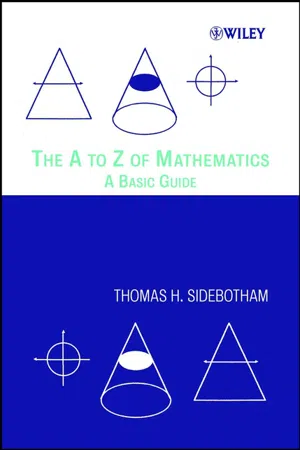Mathematics
Altitude
In mathematics, altitude refers to the perpendicular distance from a vertex of a triangle to the opposite side. It is used to calculate the area of a triangle and is a key concept in geometry. Altitude helps in understanding the relationship between the sides and angles of a triangle, and is essential for solving various geometric problems.
Written by Perlego with AI-assistance
Related key terms
1 of 5
3 Key excerpts on "Altitude"
- eBook - PDF
The A to Z of Mathematics
A Basic Guide
- Thomas H. Sidebotham(Author)
- 2003(Publication Date)
- Wiley-Interscience(Publisher)
References: Angle Sum of a Triangle, Geometry Theorems. ANGLE 21 Altitude This word is used in two different ways. The Altitude of an object is the distance of the object above the surface of the earth, and is often called its vertical height. In geometry, Altitude takes on a slightly different meaning, and refers to the Altitude of a polygon or a polyhedron. In this context, the term Altitude is explained under the entry Base (geometry). References: Base (geometry), Concurrent, Polygon, Polyhedron. AMPLITUDE Amplitude is a feature of periodic curves, like the sine or the cosine curves. The amplitude of the sine curve is the greatest distance of a point on the curve from the x -axis, and is indicated by a in the figure. For the sine curve y = sin x, the amplitude is a = 1. For the curve y = 2 cos x, the amplitude is a = 2. a 0 0 2 −2 =sin =2 cos References: Cycle, Frequency. ANALYTICAL GEOMETRY Reference: Cartesian Coordinates. ANGLE This is a measure of turning or rotation; the units of angle measurement are degrees or radians. The angle x in the figure is the amount of turning between two rays → OA and → OB. The symbol for angle is . The angle in the figure can be represented by the three capital letters, AOB, or by a single small letter, x . It is also common in trigonometry to represent an angle by the letters of the Greek alphabet, for example, θ , α, or β . 22 ANGLE BETWEEN A LINE AND A PLANE A B x O References: Acute Angle, Degree, Radian, Ray. ANGLE BETWEEN A LINE AND A PLANE This topic is part of three-dimensional trigonometry. To find the angle between a line and a plane, the line is projected onto the plane, and then the angle between the projected line and the original line is calculated. This angle is the angle between the line and the plane. Suppose a straight nail ON is hammered into a piece of wood at an angle so that the nail is not upright (see figure a). The projection of the nail ON onto the plane of the wood is OW, as shown in figure a. - eBook - PDF
Performance of the Jet Transport Airplane
Analysis Methods, Flight Operations, and Regulations
- Trevor M. Young, Peter Belobaba, Jonathan Cooper, Allan Seabridge, Peter Belobaba, Jonathan Cooper, Allan Seabridge(Authors)
- 2019(Publication Date)
- Wiley(Publisher)
Height Scales and Altimetry . Introduction The terms height and Altitude are often used interchangeably; however, in an aviation context, height is understood to be a vertical measure of distance from a defined datum according to a defined scale, but Altitude is specifically understood to be pressure height measured from a defined pressure datum. Pressure height is one of four height scales (see Section 5.2) that are used in airplane performance work—these are geometric height, geopotential height, pressure height, and density height. Altimetry (discussed in Section 5.3) is the science of measuring Altitude using an altimeter, which provides a measure of height by comparing atmospheric pressure to a reference pres-sure value (or setting). In routine flight operations, three altimeter reference settings—namely, QNH, QFE, and QNE (or STD)—are used. These settings are explained and their use in flight operations described. The world’s navigable airspace is divided into three-dimensional blocks (segments), which generally follow the International Civil Aviation Organization (ICAO) classification system. The rights of pilots to fly at particular heights and the rules associated with the operation of an airplane in controlled airspace are highly regulated. Flight levels and flight tracks are defined to ensure safe separation of traffic. These topics are discussed in Section 5.4. . Height Scales 5.2.1 Geometric Height Geometric height ( h ) is the true vertical distance from a datum level, which is usually mean sea level (MSL), to the point of interest. In airplane performance work, geometric height (which is sometimes called tapeline height) is normally confined to the context of the height of flight obstacles, such as aerials and buildings, and the elevation of airports and terrain. - Kevin Corner, Leslie Jackson, William Embleton(Authors)
- 2013(Publication Date)
- Thomas Reed(Publisher)
What is the height of the building? 158 • Mathematics The angle of elevation of an object is the angle through which the eye is raised above the horizontal to see the object. The angle of depression is the angle below the horizontal when looking down on an object. E D A diagram of the situation is crucial. 20° 52 m h ∴ tan 20 = h 52 ∴ h = 52 × tan 20 = 52 × 0. 3640 So h = 18.93 m to 2 decimal places Bearings Bearings refer to the direction of one point from another point. Sometimes they are given in the form north-east ( NE ), west ( W ) etc. but usually they are given as three-figure numbers. The bearing represents the angle turned from North in a clockwise direction. Trigonometry and Geometry • 159 Some examples are shown below: (a) (b) (c) N N N 270° 200° (Due west) 045° To solve some questions involving bearings it is necessary to have a suitable diagram showing angles and distances clearly, calculating some angles using basic geometry, before even considering Pythagoras’ Theorem or basic trigonometry. Example A ship sails for a distance of 15 km on a bearing of 250 ◦ . How far south from the original position is the ship? N 250° 20° 15 km d F S S is the start position and F the final position. Let d represent the distance south of S . sin 20 = d 15 ⇒ d = 15 × sin 20 = 15 × 0. 3420 = 5.13 km Questions 1. A ship is 3 km from the foot of a 150 m high cliff. What is the angle of depression of the ship from the cliff top? 160 • Mathematics 2. A square has sides of length 7 cm. Find the distance from the mid-point of one of the sides to either end of the opposite side. 3. From the top of a 90 m high cliff the angle of depression of a boat at sea is 15.3 ◦ . How far is the boat (i) from the cliff? (ii) from the observer? 4. What is the angle of elevation of the top of a tree 8 m high from a point on the ground 9.2 m away from the foot of the tree? 5. Find the sides of the right-angled triangle ABC if the sides of the square are 8 cm.
Index pages curate the most relevant extracts from our library of academic textbooks. They’ve been created using an in-house natural language model (NLM), each adding context and meaning to key research topics.


